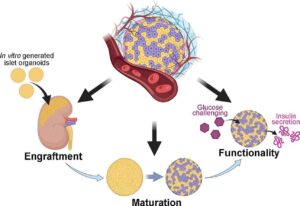What is metformin’s secret sauce? New study shows how ‘wonder drug’ works in living animals from Northwestern University, published by MedicalXpress.com, 18 December 2024.
 A new Northwestern Medicine study has provided direct evidence in mice that the drug reversibly cuts the cell’s energy supply by interfering with mitochondria to lower glucose levels. More specifically, metformin blocks a specific part of the cell’s energy-making machinery called mitochondrial complex I. In doing so, the drug can target cells that may be contributing to disease progression without causing significant harm to normal, healthy cells. The study is published in the journal Science Advances.
A new Northwestern Medicine study has provided direct evidence in mice that the drug reversibly cuts the cell’s energy supply by interfering with mitochondria to lower glucose levels. More specifically, metformin blocks a specific part of the cell’s energy-making machinery called mitochondrial complex I. In doing so, the drug can target cells that may be contributing to disease progression without causing significant harm to normal, healthy cells. The study is published in the journal Science Advances.
“This research gives us a clearer understanding of how metformin works,” said corresponding author Navdeep Chandel, the David W. Cugell, MD, Professor of Medicine (Pulmonology and Critical Care), an investigator with the Chan Zuckerberg Initiative and a professor of biochemistry and molecular genetics at Northwestern University Feinberg School of Medicine. The study’s first author is Colleen Reczek, research assistant professor of medicine (pulmonary and critical care medicine) at Feinberg.
“This research significantly advances our understanding of metformin’s mechanism of action,” Chandel said. “While millions of people take metformin, understanding its exact mechanism has been a mystery. This study helps explain that metformin lowers blood sugar by interfering with mitochondria in cells.”
Read more:
Islet Organoids: A New Hope for Islet Transplantation in Diabetes by Xeumei Yu et al and published in Frontiersin.org, 5 December 2024.
 Recent advancements in organoid technology provide transformative solutions for islet regeneration. This review summarized three groundbreaking approaches: islet organoids differentiated from Procr+ pancreatic progenitor cells, chemically induced pluripotent stem cells (CiPSCs), and endoderm stem cells (EnSCs).
Recent advancements in organoid technology provide transformative solutions for islet regeneration. This review summarized three groundbreaking approaches: islet organoids differentiated from Procr+ pancreatic progenitor cells, chemically induced pluripotent stem cells (CiPSCs), and endoderm stem cells (EnSCs).
This review highlights the potential of organoid-based technologies to revolutionize diabetes treatment and pave the way for personalized, curative therapies. The final, formatted version of the article will be published soon.
Read more: Islet Organoids: A New Hope for Islet Transplantation in Diabetes
EssilorLuxottica acquires AI startup to bolster hearing loss technology reported by GlobalData.com, December 2024.
 EssilorLuxottica has acquired French startup Pulse Audition as it looks to embed AI-based speech enhancement into its glasses. One of EssilorLuxottica’s product lines is smart lenses fitted with acoustic technology, a combination that removes the stigma of traditional hearing aids according to the company. By acquiring Pulse Audition, EssilorLuxottica says the technology brought on board will “complement proprietary hardware and software,” improving the long-term quality of products.
EssilorLuxottica has acquired French startup Pulse Audition as it looks to embed AI-based speech enhancement into its glasses. One of EssilorLuxottica’s product lines is smart lenses fitted with acoustic technology, a combination that removes the stigma of traditional hearing aids according to the company. By acquiring Pulse Audition, EssilorLuxottica says the technology brought on board will “complement proprietary hardware and software,” improving the long-term quality of products.
Pulse Audition has developed frames with a microphone array that scans the audio environment and detects to whom the user is listening. Gyroscope technology in the glasses can also tell where the user is looking via head movements, allowing personalized targeting of voice isolation. Embedded AI then enhances speech and takes away unwanted background noise.
EssilorLuxottica, the biggest manufacturer of ophthalmic lenses and eyeglasses in the world and owner of brands such as Ray-Ban, has already developed a hearing solution called Nuance Audio. Using technology it acquired from Nuance Hearing in 2023, the company has made progress in the hearing solutions space as it looks to offer a new approach for those with mild to moderate hearing loss. The Nuance Audio frames are expected to cost $1,100.
Read more: EssilorLuxottica acquires AI startup to bolster hearing loss technology
FDA Approves First Generic of Once-Daily GLP-1 Injection to Lower Blood Sugar in Patients with Type 2 Diabetes was announced by FDA.gov/news, 23 December 2024.
 The U.S. Food and Drug Administration approved the first generic referencing Victoza (liraglutide injection) 18 milligram/3 milliliter, a glucagon-like peptide-1 (GLP-1) receptor agonist indicated to improve glycemic control in adults and pediatric patients aged 10 years and older with type 2 diabetes as an adjunct to diet and exercise.
The U.S. Food and Drug Administration approved the first generic referencing Victoza (liraglutide injection) 18 milligram/3 milliliter, a glucagon-like peptide-1 (GLP-1) receptor agonist indicated to improve glycemic control in adults and pediatric patients aged 10 years and older with type 2 diabetes as an adjunct to diet and exercise.
The FDA approved the first generic in this class of medications last month with the approval of a generic referencing Byetta (exenatide). Liraglutide injection and certain other GLP-1 medications are currently in shortage. The FDA prioritizes assessment of generic drug applications for drugs in shortage to help improve patient access to these medications.
“The FDA supports development of complex generic drugs, such as GLP-1s, by funding research and informing industry through guidance as part of our ongoing efforts to increase access to needed medications,” said Iilun Murphy, M.D., director of the Office of Generic Drugs in the FDA’s Center for Drug Evaluation and Research. “Generic drugs provide additional treatment options which are generally more affordable for patients. Today’s approval underscores the FDA’s continued commitment to advancing patient access to safe, effective and high-quality generic drug products.”
 According to Scott Strumello, who authors a wonderful newsletter, Scott’s Web Log, this version will be sold by Hikma Pharmaceuticals USA. The first generic hit the market on June 24, 2024 when the U.S. unit of Teva Pharmaceuticals brought that to market. What made Teva’s generic unique was that it became an “authorized generic” which was made with the innovator Novo Nordisk’s permission. In fact, Teva’s liraglutide is packaged in Novo Nordisk’s proprietary FlexPen devices. However, at present, the generic products are only approved for the treatment of Type 2 diabetes, but not for obesity without T2D. The expectation is that once these are on the market, the generics makers will apply for a label-extension for obesity just as Novo Nordisk did.
According to Scott Strumello, who authors a wonderful newsletter, Scott’s Web Log, this version will be sold by Hikma Pharmaceuticals USA. The first generic hit the market on June 24, 2024 when the U.S. unit of Teva Pharmaceuticals brought that to market. What made Teva’s generic unique was that it became an “authorized generic” which was made with the innovator Novo Nordisk’s permission. In fact, Teva’s liraglutide is packaged in Novo Nordisk’s proprietary FlexPen devices. However, at present, the generic products are only approved for the treatment of Type 2 diabetes, but not for obesity without T2D. The expectation is that once these are on the market, the generics makers will apply for a label-extension for obesity just as Novo Nordisk did.
That said, FDA’s own research has proven with all drug classes that the more generics which are on the market, the lower prices become much lower on average. While the narrative from Novo Nordisk is that its newest GLP-1s are vastly superior, in fact, they are new-and-improved GLP-1s, the reality is they deliver moderately better weight-loss and slightly lower HbA1c with extended-release (meaning fewer doses), they never admit that the prices of the newest GLP-1 products are like 1300 per cent higher.
Read more: FDA Approves First Generic of Once-Daily GLP-1 Injection to Lower Blood Sugar
How to calm your mind with breathing, according to science by Richard Sima for WashingtonPost.com, 1 January 2025. Breathwork practices and slowing our breath can alleviate stress and improve mood. Perhaps, this a a great tool for you to practice, in coping with Type 1 diabetes stresses, in 2025.
The relationship between our breath, body and brain has been known for at least 1,500 years, said Paul Dallaghan, a breathwork expert and researcher who is publishing a review on the history of yoga. “One reflects the other. As the breath moves, the mind moves,” he said, citing yoga texts.
With every inhale, the pupils in our eyes tend to dilate, our reaction time quickens and our ability to remember and recall information becomes more efficient. At the same time, our response to emotional information heightens, and we are also less likely to make a voluntary movement.
And when we exhale, the opposite happens.
Most people breathe an average of 12 to 20 times a minute, though the rate varies from person to person and circumstance to circumstance. More anxious people tend to breathe faster. However, the “magic number” of calming breaths is around 5.5 to 6 breaths per minute — far slower than most people hit, Dallaghan said. This number comes from observations of people in meditative states — moments of calm, quiet and clarity when breathing would spontaneously slow.
 Slowing down our breath may help to rebalance our autonomic system away from a sympathetic “fight-or-flight” mode toward a parasympathetic “rest-and-digest” one, said Guy Fincham, an associate researcher at Brighton and Sussex Medical School interested in “all things breathwork.” Breathing sends signals from our body to our brain through the vagal nerve, and slower and deeper breaths activate the nerve more potently, Lavretsky said. “When the vagal nerve activates, it’s like a big red sign,” she said. “When all systems stop, you stop worrying.”
Slowing down our breath may help to rebalance our autonomic system away from a sympathetic “fight-or-flight” mode toward a parasympathetic “rest-and-digest” one, said Guy Fincham, an associate researcher at Brighton and Sussex Medical School interested in “all things breathwork.” Breathing sends signals from our body to our brain through the vagal nerve, and slower and deeper breaths activate the nerve more potently, Lavretsky said. “When the vagal nerve activates, it’s like a big red sign,” she said. “When all systems stop, you stop worrying.”
A recent study reported that even just five minutes of breathwork each day for about a month could reduce breathing rate, improve mood and reduce anxiety. “Our conclusion is that breathwork is not a placebo response. It may be present in all mammals,” Jack Feldman, chair of the neuroscience department at the University of California at Los Angeles said. “And we may be the only species that takes advantage of it.”
Read more: How to calm your mind with breathing, according to science






Sure, what EssilorLuxottica has done for glasses, they now want to do to hearing aides. Isn’t that incredible? Think of how little glasses cost these days. Oh, I cannot wait. LOL
Metformin is wonderful,
Congratulations on 60 years!